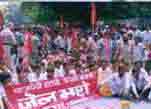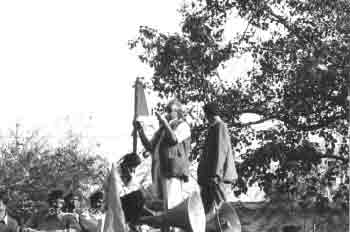 |
Oust Saffron Campaign: Comrade Vinod Mishra addressing AISA-RYA rally on 30-11-1998 |
The BJP-led NDA government came to power in 1998, and saffron rule soon overshadowed India. The CPI (ML) lost no time in taking the saffron bull by its horns and launched a nationwide “Oust Saffron, Save the Nation Campaign”. From major cities to remote villages, people under the ML banner protested against the “Hindu Bomb” at Pokharan. As prices of essential commodities soared sky high, members of AIPWA formed the front ranks of the protest. When the saffron brigades vandalised the sets of the movie ‘Water’, students mobilised by AISA challenged the VHP claim to represent ‘Indian culture’ and marched on the streets of Benaras in defense of filmmakers’ rights to portray the oppression of widows. When goons of Shiv Sena and Bajrang Dal attacked a programme featuring the renowned ghazal singer Ghulam Ali and whipped up anti-Pak jingoism, students and youth with AISA and RYA at the forefront, protested all over the country.
The saffron menace faced a ‘Red Challenge” at the height of the “Oust Saffron” campaign, with massive rallies flooding the streets of various states from Tamil Nadu, Andhra Pradesh to Assam, Punjab, Bengal, UP and Bihar. Bihar witnessed a virtual “Red October”, with CPI (ML) rallies being held in one district after another.
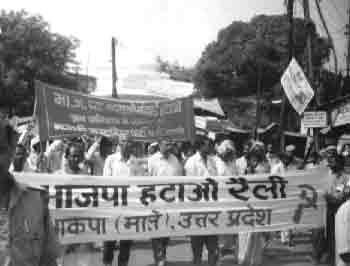 |
BJP Hatao Rally at Lucknow on 12
October 1998 |
At Lucknow, a colourful and militant procession of 10,000 people marched on 12 October, giving voice to popular resentment against the Kalyan Singh govt. for its communal, criminalised and anti-people governance.
During the last few years, in UP the BJP have tried to replicate its ‘Gujarat Experiments’. But, due to a great extent to the militant mobilisations of the CPI (ML), the rural poor and tribals rejected the path of communal bigotry, and opted for radical struggles in the face of fierce state repression. In October 2000, the AISA, RYA and CPI (ML) gheraoed the UP Assembly, protesting against the police- mafia raj of the Rajnath government, fee hikes, and the saffron branding of Aligarh Muslim University (AMU) as an ‘ISI den’. In November ’01, CPI (ML) won a landmark battle in eastern UP against a dress reversal of the POTA regime. CPI (ML) activists and leaders of Mirzapur district, who had been the lone voices of protest against police murders of peasants in fake encounters in the same region, were illegally arrested and subjected to brutal torture. CPI (ML) leaders including the State Secretary Comrade Akhilendra were arrested as well, sparking off a series of militant protests, due to which all the arrested comrades were released unconditionally. The CPI (ML) rally at Mirzapur on 5 December which boldly raised slogans saluting the revolutionary and legacy of Naxalbari, was a fitting rebuff to the Rajnath Govt’s repeated attempts to brand CPI (ML) and AISA as “fronts” for “terrorist groups”.
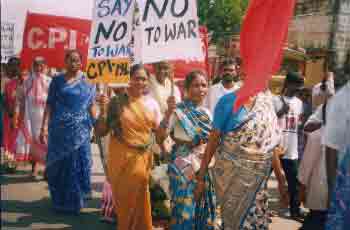 |
Women leading a peace march in Kakinada |
Pokharan, Kargil, anti-Pak muscle flexing ... ... the BJP-led NDA has repeatedly used anti-Pak jingoism as a smokescreen for its sell-out of India’s economic and diplomatic sovereignty to US-led imperialism.
Meanwhile the mainstream opposition has indulged in competitive war hysteria on each occasion.
In 1999, it was the CPI (ML) alone, which unhesitatingly came out on the streets, categorically condemning war and calling for peace. Courageously and unconditionally, the CPI (ML) went to masses and mobilised them to call for an end to the Kargil conflict. Students, youth and women were the voices of peace and sanity, even as the BJP, as well as the parties claiming to oppose it, competed to cash in on war hysteria. When youth seeking recruitment in the army were gunned down at Darbhanga and Chapra, soon after Kargil, AISA, RYA and the CPI (ML) channelised the spontaneous anger into protests which exposed the hypocrisy of the ruling elite which used poor, unemployed youth as cannon fodder for its war machine.
When Tehalka flipped the lid off the can of worms that was the defense establishment and the ‘super-patriotic’ BJP, it was the CPI (ML) that organised a militant ‘Vajpayee Hatao’ campaign in August 2001, with “Rasta Roko/Rail Roko” agitations all over India.
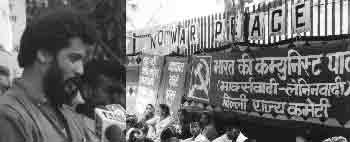 |
No to War, Yes to Peace : Joint
Left Demonstration in Delhi, May 2002 |
Following the WTC bombing, the BJP was desperate to woo the US —make Pakistan a target for its racist ‘war on terror’. Even as the ruling classes of India and Pak escalated the tensions between them, the CPI (ML) joined by other Left groups, organised anti-war demonstrations all over India. On June 13, they synchronised with the peace demonstrations at Lahore organised by four Left parties of Pakistan. On both sides of the border, people’s voices could be heard over the din of war cries, shouting “Bread, Not Bombs”, “Withdraw Forces from the Borders”, “No to War, Yes to Peace”, and “ US Imperialism, get out of the Indian subcontinent”!
During the BJP rule of the last five years, US imperialists have been given opportunities and encouragement to fish in the troubled waters of the subcontinent. The NDA govt. rolled out the red carpet for Clinton in April 2000, for Powell in Jan 2002. The BJP and its NDA govt. acted as a willing pawn of US imperialism, imposing the diktats of the IMF-WB-WTO on the Indian people. Hindutva fascism found a mirror image in US-backed Zionist expansionism, and the BJP govt. distorted Indian foreign policy, backing Israel in its blatant aggression against Palestine. CPI (ML) rose to the occasion every time, with a series of anti-imperialist protests.
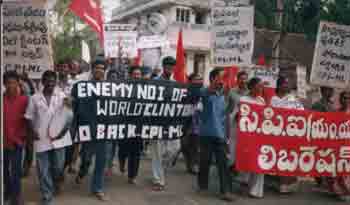 |
Clinton Go Back: March to American
Center in Calcutta |
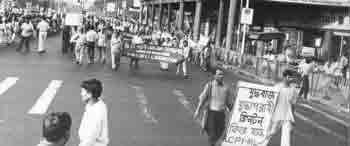 |
in Hyderabad on 24 March 2000 |
When Clinton came to India, and Indian leaders vied to prostrate themselves before him, thousands on the other side of the barricade greeted him with red flags, telling the “World’s Terrorist No. 1" to “Go Back”. The day Clinton set foot in Delhi, CPI (ML) burnt his effigy at the busy ITO crossing. On the day Clinton addressed Parliament, CPI (ML) gave a call for a nationwide protest. In Delhi the CPI (ML), led by its General Secretary Dipankar Bhattacharya, and CPI (ML) Member of Parliament, Jayanta Rongpi, who boycotted the session, marched to Parliament, broke police barricades and courted arrest. At Hyderabad, Clinton was greeted on his arrival by a massive rally by 9 Left parties including the CPI (ML). At Calcutta, when CPI (ML) activists broke the barricades at the American Centre, they faced a brutal lathi-charge by the WB police.
In Jan. ’02, when Colin Powell came to play the “Third Umpire” in the subcontinent, CPI (ML) protests all over the country and decisively told him to “Go Back”.
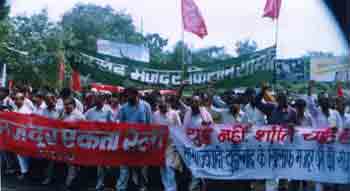 |
Massive anti-war rally by AICCTU
at Dhanbad on the inaugural day of its national conference |
The CPI (ML), anticipating the US war on Afghan people, launched anti-war marches and protests all over India between 24-29 Sept. ’01. The US air strikes began on 7 October, and on 8 October, thousands of workers, assembled for AICCTU’s National Conference at Dhanbad, took out a massive anti-war rally led by CPI (ML) General Secretary Dipanker Bhattacharya.
On 9 November, the CPI (ML) and its peasant organisation, the AIKSS, organised a historic rally at Delhi in protest against the Afghan war and the Vajpayee govt.’s capitulation of the anti-people WTO at Doha. This rally was the largest anti-war, anti-WTO rally to be held in India.
In this largest anti-war, anti-WTO rally to be held in India, the poorest and most downtrodden of this country unfurled the red banner of revolutionary struggles and announced their intention to wage a decisive war against “US imperialism, and their official agents in India, from Doha to Kabul”.
Against the US-Israel colonial war against Palestine, CPI (ML), AISA and RYA activists all over India demonstrated in solidarity with Palestinians, telling “Terrorists Bush and Sharon” to keep their “Hands Off Palestine”.
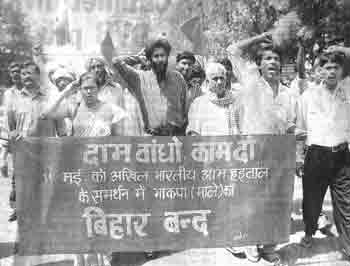 |
May 11, 2000: Bihar Bandh to observe
Dam Bandho Kam Do |
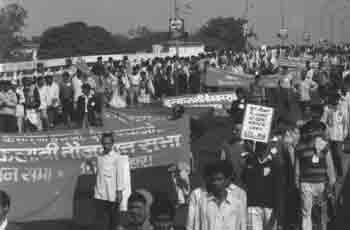 |
AISA-RYA Parliament March on 30-11-1998 |
Right from 1998, students and youth under the banner of AISA and RYA had galvanised themselves to challenge the distortion of education by the BJP’s policies of saffronisation and privatisation. In August ’98, more than 10,000 students and youth under the banner of AISA RYA took out a massive march on the streets of Patna, followed by the 3rd National Conference of AISA. Responding to the call by this Conference, all-India students strike was observed on 21 September, with campuses all over India speaking out against fee hikes, privatisation and saffronisation. Striking students in Allahabad gheraoed the HRD Minister Murli Manohar Joshi, shouting slogans like “Reactionary Joshi, Destroyer of Secular Education, Go Back!”.
On March 31, 2000, the RYA commemorated the Martyrdom Day of Comrade Chandrasekhar by holding a militant march and a National youth convention against the anti-national, bigoted, pro-imperialist policies of the BJP-led NDA government. The convention called for a ‘Parallel Parliament’ by student and youth that was organised by AISA and RYA in April 2000. At this ‘Parallel Parliament’, thousands of students and youth from all over India participated, as well as historians and educationists. The ‘Parliament’ debated a detailed charge sheet against the BJP-led govt., and launched a nation-wide ‘Daam Bandho, Kaam do’ movement.
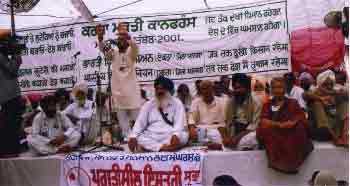 |
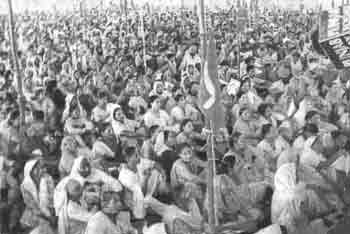 |
Even as the policies of globalisation assault India’s agrarian economy, pushing rural poor to starvation and driving farmers to suicide, militant protests by peasantry under the revolutionary red banner have risen up in resistance. A landmark has been the All India Kisan Conference organised by the CPI (ML) at Faizabad. In the massive Kisan rally held on the occasion on 3 March ’02, the All India Kisan Sangharsh Samiti was launched.
In September ’01, the AIKSS along with BKU (Ekta) held a massive “Freedom-from-Debt” rally-cum-convention at Mansa, Punjab, from where the call was issued for a massive rally against the WTO on 9 November at Delhi.
If peasants have been on the warpath, workers have not been far behind. Whether it was Peenya factory workers in Bangalore or Dunlop workers in Tamil Nadu against factory closures, job cuts and de-industrialisation, AICCTU has been at the forefront of several militant struggles. In Delhi, when a Supreme Court directive ordered the closure of small industries and eviction of workers, spontaneous militant protests were followed by a massive CPI (ML) ‘Pratirodh Rally’, where thousands marched raising the cry that ‘Delhi is not the Jagir of Jagmohans / It belongs to the Working People!’.
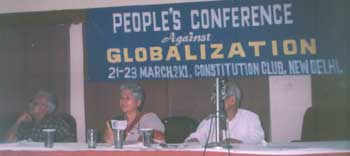 |
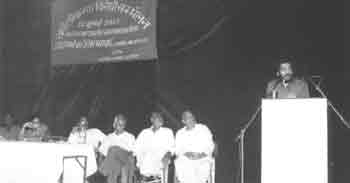 |
The CPI (ML) also took initiatives to forge new platforms of united struggle against globalisation. One such landmark was the "People’s Conference Against Globalisation" held in Delhi from March 21-23, 2001. An entire spectrum of activists and leaders, ranging from communist parties, trade Unions to people’s movements and intelligentsia, participated in this Conference. Strategies and experiences of fighting globalization offensives were shared and resolutions were made for broader, united mobilisations against globalization. Prominent among the participants were B Sivaraman, Kishan Patnaik, Medha Patkar, BD Sharma, Justice VR Krishna Iyer, Vandana Shiva, KN Kabra, Prabir Purkayastha, SP Shukla and others. The Conference was inaugurated by Walden Bello, director of ‘Focus on the Global South’, who is one of the leading theorists of the global anti-corporate movement.
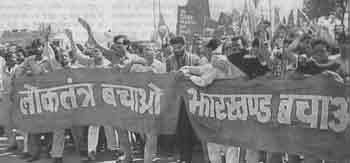 |
In the newly formed state of Jharkhand, the CPI (ML) took the lead in voicing the sense of betrayal and disillusionment felt by tribals and workers. The CPI (ML) stormed the first budget session of the Jharkhand Assembly on 27 Feb’01, protesting against state terror, and the anti-people Koel Karo project, which was displacing hundreds of tribals. The CPI (ML), collided head-on with saffron state repression, with the brutal lathi-charge on the huge rally and the arrest of the Party General Secretary, Dipankar Bhattacharya. A series of militant protests followed in which the leader of the NBA, Medha Patkar, and noted anti-globalisation campaigners like Prabhash Joshi, participated. In the face of the swelling protests, Comrade Dipankar was released, and the CPI (ML) organised a ‘Save Democracy’ rally at Ranchi on 14 March. More than 10,000 demonstrators flooded the streets of Ranchi, violating the Section 144 imposed by the Marandi Govt.
The Marandi Govt’s attempts to impose police raj once again reared its ugly head in March 2002. Jharkhand witnessed a spate of massive rallies in this month: a 10,000 strong Samajik Parivartan Rally at Jamua, a 7,000 strong Bhrastachar-Virodhi Rally at Deori, a 5,000 strong rally at Saria, and a 7,000 strong Chunauti Rally at Birni, among others. In retaliation, Marandi’s police cracked down on CPI (ML) leaders, arresting CPI (ML) MLA Mahendra Singh on 2 April’02. A massive Giridih Bandh on 4 April, and statewide protests followed, including a militant blockade of coal movement in coalfields all over Jharkhand … until the CPI (ML) leader was released.
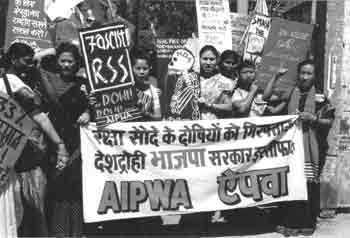 |
In other states too, state repression and anti-people policies faced stiff resistance by the CPI (ML). The CPI (ML) has led a protracted struggle of the fisher folks for defending Chilika Lake of Orissa, against the prawn-mafia. The CPI (ML) gheraoed Chandrababu Naidu in Andhra Pradesh, and along with other left parties demanded redressal of farmers’ suicides due to globalisation policies.
Students in Uttaranchal have spearheaded massive protests, expressing anger at the betrayal of people’s aspiration by the successive governments.
In Assam, the CPI (ML) has been at the forefront of mass mobilisation against state repression and for autonomy for the hill people.
In Bengal, a spirited demand for justice for the martyrs of Naxalbari, and to protest against the continuing crackdown on activists, dissidents and revolutionaries by the CPI (M)- led LF govt., was led by CPI (ML).
Women under the banner of AIPWA have challenged the reactionary, patriarchal BJP govt. head on repressive, anti-people state governments have faced the ire of the women’s movement.
In March ’01, following the Tehalka revelations, a huge women’s rally marched on the streets of Patna, against the fascist RSS, and anti-national BJP govt.
In June’02, AIPWA took a team to genocide-ravaged Gujarat to assess the Govt’s claim of ‘normalcy’ in the state.
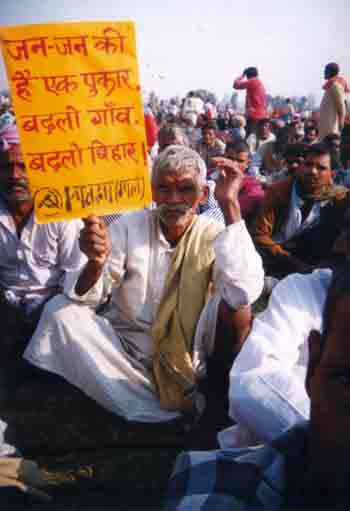
|
From massive protests against the Bathe massacre and Mianpur Massacre by the Ranvir Sena, to various mass rallies and bandhs on the issues of development, democracy, rights and dignity, CPI (ML) in Bihar has lived up to its role of consistent revolutionary voice of the rural poor in Bihar. A massive rally at Patna in December 1999 gave the call to “Badlo Bihar”(Transform Bihar). In July 2000, CPI (ML) activists stormed the Bihar Assembly in a historic protest against the massacres of landless poor and dalits by the state-patronised, RSS-backed Ranvir Sena. In August 2000, following the formal bifurcation of Bihar, the CPI (ML) led a massive march to Parliament demanding a special central package for Bihar’s development The CPI (ML)’s intensive campaigns also sensitised people about the need for radical, militant movements to smash the forces determined to perpetuate Bihar’s economic and social backwardness. Significant among these campaigns was the series of protests in the Mithilanchal region on the question of a lasting solution to ravages by floods.
The BJP govt., in the name of fighting terrorism, introduced draconian black law, especially POTA, to crush popular movements. Ever since POTO was introduced, the CPI (ML) has defied and challenged it, at the grassroots as well as through protests, against bans on Left groups.
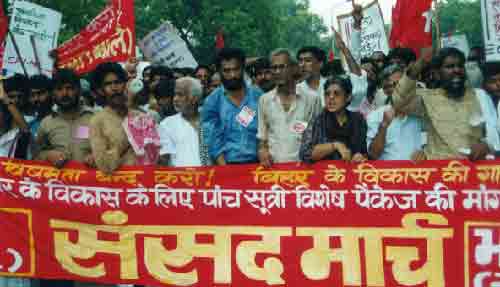
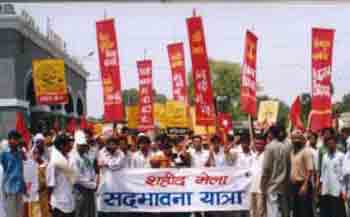 |
In the past year, the BJP-RSS has once again been whipping up tensions over and in the wake of its Ayodhya campaign, has perpetrated the Gujarat carnage- the worst genocide in India’s recent history. A day before the VHP’s ‘Shila Pujan’ charade at Ayodhya on 15 March, the CPI (ML) launched a massive rally at Patna with the slogan of “Save democracy from Communal Fascism”. Nearly 1,00,000 people participated in the massive rally against the Gujarat carnage and the Ayodhya hate Campaign.
On 10 May, AISA, RYA, AIPWA and Jan Sanskriti Manch organised a ‘Shaheed Mela’ at Faizabad-Ayodhya, in memory of the martyrs of the 1857 First War of Independence. The Mela was banned by the local administration, with the Mayawati govt. succumbing to pressure by the RSS. But thousands of students, youth and women vowed to challenge the saffron monopoly over Ayodhya and to reassert Ayodhya legacy united Hindu-Muslim struggle against imperialism in 1857. In the crackdown that followed, nearly a thousand were incarcerated for a week in jails of Mau, Faizabad and Sultanpur. But the popular response to the Mela was enormous, and the Ayodhya convention was held in defiance of the ban, demanding a strict separation of religion and politics, ban on VHP and other Sangh outfits and an amicable, secular solution to the Ayodhya dispute. No temple or mosque should be a symbol of nationalism in a secular country and the convention also gave expression to the popular demand for a ‘martyrs memorial’ for the 1857 martyrs at Ayodhya, which was a truly fitting tribute to the nationalist legacy of Avadh,
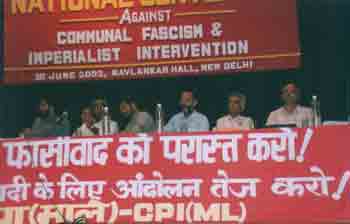 |
On 26 June, the CPI (ML) took the initiative of organising a national convention against ‘Communal Fascism and Imperialist Intervention’, in which a range of left parties and activists of people’s movements participated. This convention gave a call for a nationwide “Saffron brigade, Quit India” protest on 9 August ’02, the anniversary of the Quit India Movement. All over the country, CPI (ML) activists filled jails in thousands, vowing to intensify the struggle to free India from saffron rule.
On 28 September 2002, the CPI (ML) held a nationwide “Anti-communal Fascism, Anti-Terrorism” protest. The most significant of these was the massive Ahmedabad March, in which a range of Left parties and democratic figures participated, challenging the Modi govt.’s attempts to cash in on the genocide as a run up to elections.
|
||
Oust Vajpayee Campaign: Jail Bharo
on 9 August 2000 |
||
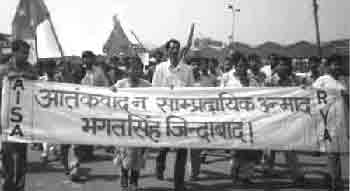 |
||
AISA-RYA march against communal fascism
and terorrism on 28 September |
In Delhi, AISA and RYA commemorated 28 September as Bhagat Singh’s birth anniversary. Students and youth from all over India marched to Ferozshah Kotla Grounds, where Bhagat Singh and his comrades had founded their revolutionary party. There, a ‘Sankalp Sabha’ was held, where students and youth pledged to carry forward Bhagat Singh’s legacy of revolutionary socialism, and struggle against imperialism and communal fascism. His nephew, Prof. Jagmohan, released a book on Bhagat Singh’s ideas and struggles and the participants declared that if Bhagat Singh had sacrificed his life to throw out the ‘white sahibs’, they would fulfill his dream of overthrowing the anti-people ‘brown sahibs’!
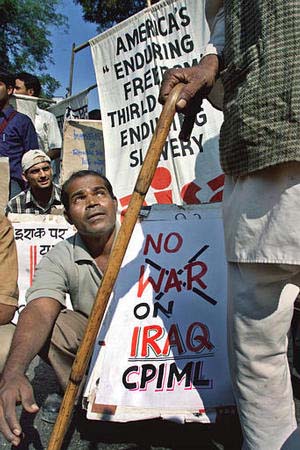 |
BJP Hatao Rally at Lucknow on 12
October 1998 |
Iraq is the next target picked up by the US imperialists after Afghanistan in their global war of agression. Protests against the US designs are coming up from almost every corner of the globe. Joining this worldwide resistance against the US, Left parties in India brought out a joint procession in Delhi on 14 November 2002 to protest the American war threats against Iraq.

